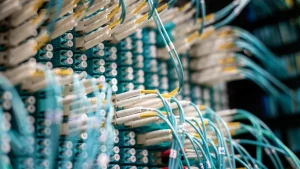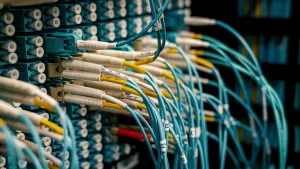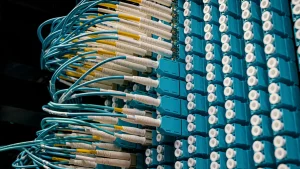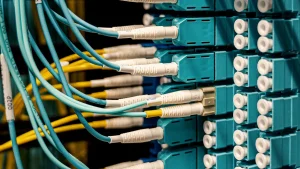
Leading MPO Trunk Cable manufacturers such as Amphenol and Sumitomo Electric hold significant global market shares, with Amphenol at 17% and Sumitomo at 14%.
- Asia-Pacific drives 38% of demand, especially in data centers and 5G.
- Industry leaders excel in product quality, innovation, global reach, and customer support.
| Aspect | Details |
|---|---|
| Key MPO Trunk Cable Players | Corning, OFS, CommScope, Prysmian Group, BERK-TEK, Legrand, Belden, AFL, Furukawa, YOFC, Amphenol, TE Connectivity |
| Market Competitiveness | Highly competitive with several well-established companies leading globally |
| Regional Market Share | North America holds the largest share in MPO trunk cables; Asia-Pacific leads overall MPO demand |
| Market Size (2023) | USD 1,381.5 Billion |
| Market Size (2024) | USD 1,482.35 Billion |
| Market Size (2032) | USD 2,604.9 Billion |
| CAGR (2024-2032) | 7.3% |
| End User Segments | Cloud Providers (largest share), Service Providers, Enterprises |
| Regional Growth Insights | APAC expected highest growth; Europe second largest; South America and MEA smaller but steady growth |
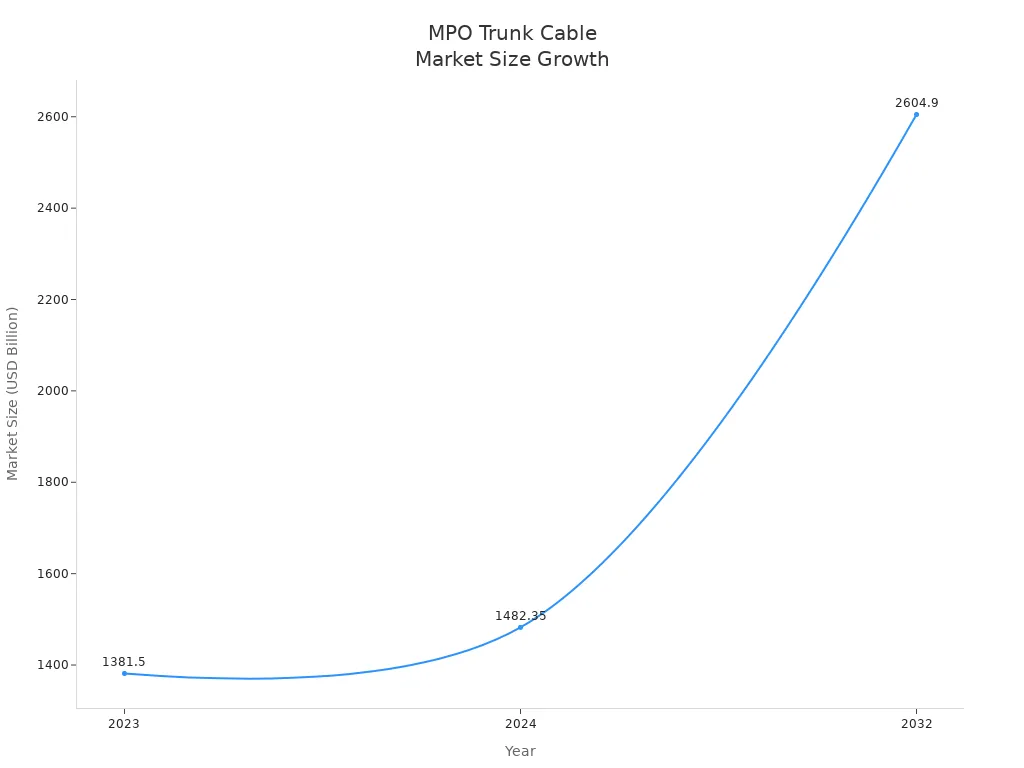
Key Takeaways
- MPO trunk cables offer high-density, scalable, and reliable fiber connections essential for modern data centers, telecom networks, and enterprise infrastructure.
- Leading companies innovate with advanced connector technologies and customizable solutions that improve installation speed, fiber density, and network performance.
- Choosing the right MPO trunk cable supplier involves considering product quality, customization options, certifications, and strong technical support to ensure future-proof and efficient network growth.
MPO Trunk Cable Company Profiles
US Conec
US Conec stands out in the MPO trunk cable industry through its patented connector technologies. The company developed the Miniature Duplex Connector (MDC) and Miniature Multi-fiber Connector (MMC), both classified as Very Small Form Factor (VSFF) connectors. These innovations enable high-density optical interconnects, which are essential for modern data centers. The DirectConec™ push-pull system simplifies insertion and extraction, making installation and maintenance more efficient. US Conec’s TMT ferrule technology further enhances reliability and density. The company’s licensing agreements with global manufacturers, such as T&S, demonstrate its leadership in connector technology for MPO trunk cable assemblies.
Amphenol
Amphenol delivers a comprehensive range of MPO trunk cable solutions tailored for high-performance environments. The company’s product lines include the C2E Fiber Distribution Chassis and Advanced Optical Modules (AOMs), both supporting modularity and scalability. Amphenol’s 800Gb/s OSFP and QSFP-DD transceivers feature MPO ports and comply with major industry standards, making them suitable for next-generation data centers.
| Product Line | Description | Key Features | Applications |
|---|---|---|---|
| C2E Fiber Distribution Chassis | Modular chassis supporting Base-8 and Base-12 modules for LC to MPO breakout | Supports HX8 Base-8 and HX/HX2 AOM modules; reversible modules; accommodates MPO fiber trunk cables | Data Center (TOR, MDA, EDA, HDA), Central Office, Headend |
| Advanced Optical Modules (AOMs) | Modules compatible with MPO fiber trunk cables, available in various configurations (LC, MPO, Patch/Splice, TAPs) | Slide trays for easy access; mountable in 19" or 23" racks; fiber management features | Same as chassis |
Amphenol’s focus on modularity and high-speed connectivity positions it as a leader in the MPO trunk cable market.
Molex
Molex drives innovation in MPO trunk cable technology with its MXC fiber optic interface. This interface supports up to 64 optical fibers, offering a 15% improvement in physical density compared to standard MPO interfaces. The MXC product line includes trunk cables, patch cords, and conversion cables for both single-mode and multi-mode fibers. Molex’s VersaBeam expanded beam MT ferrule technology increases the optical beam diameter, reducing fiber damage and cleaning requirements. This technology also improves dust and debris resistance, enhancing the robustness and reliability of MPO trunk cable connections.
- MXC interface supports up to 64 fibers for higher density.
- 15% physical density improvement over standard MPO.
- VersaBeam technology reduces fiber damage and cleaning needs.
- Product line includes trunk, patch, and conversion cables.
SENKO
SENKO’s MPO trunk cable solutions focus on ultra-high-density and rapid deployment. The SN-MT connector technology achieves 2.7 times the fiber density of traditional MPO connectors, supporting up to 16 fibers per connector and up to 3,456 fiber connections in a 1RU patch panel. SENKO’s design allows for easy installation through ducts and reduces deployment costs with pre-terminated cables. The company’s MPO EZ-Way connector features a compact design and push-pull boots, increasing patch panel density by 33%. SENKO’s products are ideal for hyperscale data centers and next-generation high-speed transceivers.
| Feature | Description |
|---|---|
| Very High Fiber Density | SN-MT connector enables up to 3,456 fibers per 1RU patch panel. |
| Reduced Connector Count | Ganging two SN-MT16 connectors reduces connector count by 50%. |
| Compatibility with 200-micron Rollable Ribbon Fiber | Supports ultra-high fiber counts for next-generation cables. |
| Faster Installation | Pre-connectorized trunk cables allow quicker deployment. |
| Compact Design & Easy Handling | Smaller connector size increases patch panel density and facilitates installation. |
| Network Benefits | Enhances agility, reduces cost, and future-proofs data center cabling. |
Panduit
Panduit offers a broad portfolio of MPO trunk cable assemblies designed for high-density data center environments. The company emphasizes modularity and scalability, allowing customers to adapt their infrastructure as network demands grow. Panduit’s solutions support rapid deployment and easy cable management, making them a preferred choice for enterprise and cloud data centers. Their focus on quality assurance and compliance with industry standards ensures reliable performance.
CommScope
CommScope maintains a strong global presence in the MPO trunk cable market. The company’s fiber cable assemblies, including MPO trunk assemblies, form a core part of its data center infrastructure solutions. CommScope’s extensive product portfolio supports rapid scaling of fiber capacity for enterprise, multi-tenant, service provider, and hyperscale data centers. The company operates manufacturing and technical support centers in key regions worldwide, ensuring product availability and responsive service. CommScope’s pre-terminated cabling solutions and technical expertise help customers build scalable and repeatable data center networks, especially as AI workloads increase the need for high-density cabling.
- Comprehensive range of MPO trunk cable assemblies.
- Supports rapid scaling for various data center types.
- Global manufacturing and support footprint.
- Pre-terminated solutions for scalable, repeatable builds.
T&S Communications
T&S Communications specializes in high-density fiber optic connectivity solutions, including MPO trunk cable assemblies. The company leverages advanced manufacturing techniques and holds licenses for key connector technologies, such as US Conec’s MDC. T&S focuses on delivering reliable, high-performance products for data centers and telecom networks. Their global reach and commitment to quality make them a trusted partner for large-scale deployments.
Sumitomo Electric
Sumitomo Electric Lightwave provides a wide range of MPO trunk cable products for data centers and enterprise networks. The company offers connectorized cable assemblies in simplex, duplex, interconnect, and trunk configurations, with fiber counts up to 864 and higher upon request. Sumitomo’s flexible plenum- and riser-rated ribbon trunk cables feature Easy Split & Peel ribbon technology, which eliminates the need for tools during installation. Customers can customize cables to exact lengths and select from various connector types, ensuring compatibility and ease of deployment. Sumitomo’s expertise in fiber manufacturing ensures high performance and compliance with industry standards.
- Connectorized assemblies for data centers and enterprises.
- Flexible, bendable cables for space-constrained environments.
- Easy Split & Peel technology for tool-free installation.
- Customizable lengths and connector options.
Fiber-Mart.com
Fiber-Mart.com has built a reputation for high customer satisfaction in the MPO trunk cable market. Customers consistently praise the quality, low fiber loss, and stable connections of Fiber-Mart.com’s products. Fast delivery, often within 4-5 days, and competitive pricing further enhance the buying experience. The company offers extensive customization options, including fiber count, cable length, connector type, jacket material, polarity, and breakout length.
| Customization Aspect | Available Options |
|---|---|
| Fiber Count | 8, 12, 24, 36, 48, 72, 144 (varies by product) |
| Fiber Type | Single Mode (G652D, G657A1), Multimode (OM1, OM2, OM3, OM4) |
| Cable Jacket Type | LSZH, OFNP |
| Breakout Length | Default, 0.3m, 0.5m, Customized |
| MPO/MTP Polarity | Type A, Type B, Type C |
| Pulling Mesh | None, End A, End B, Both Ends |
| Connector Types | MPO Male/Female, APC/UPC polish |
| Cable Diameter | 3.0mm default, custom diameters available |
| Total Cable Length | 1m to 100m+ |
| Additional Customization | Pulling eyes, special requests |
Customers frequently give 5-star ratings, citing stable performance and excellent service, especially for data center applications.
FSG Networks
FSG Networks delivers MPO trunk cable solutions that support high fiber counts up to 144 fibers in a single cable. The pre-terminated design enables quick and reliable installation, making these cables ideal for rapid network upgrades. FSG Networks ensures compatibility with fan-out patch cords and breakout modules, supporting 40G, 100G, and 400G networks. The company emphasizes high performance, with low insertion loss and high signal integrity. Rigorous quality assurance programs, including Optotest IL/RL testing and polarity testing, guarantee consistent reliability. FSG Networks also provides a variety of cable types and configurations, ensuring versatility for different applications. Their focus on customer service and compliance with industry standards makes them a strong choice for scalable network infrastructure.
Key Features of MPO Trunk Cable
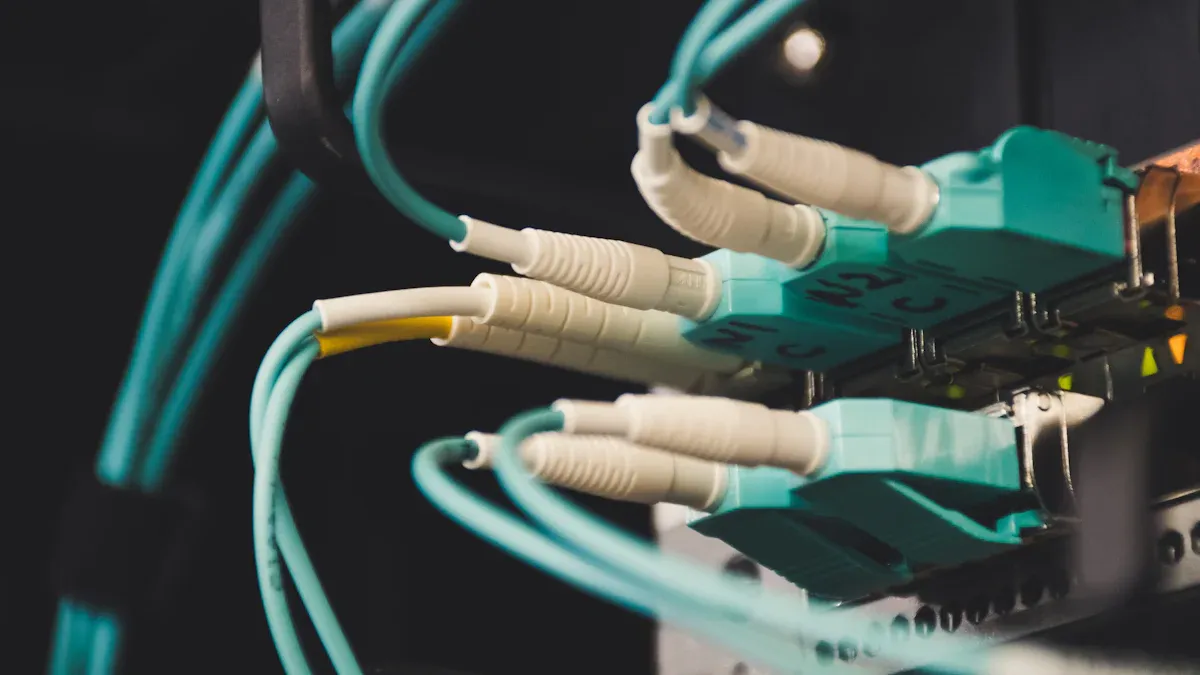
High-Density Connectivity
MPO trunk cables deliver exceptional high-density connectivity, making them essential for modern data centers and enterprise networks. These cables support a wide range of fiber counts, including 12, 24, 48, 72, and 144 fibers in a single assembly. This flexibility allows network designers to maximize fiber capacity while minimizing physical space requirements.
Industry standards such as IEC 61754-7 and EIA/TIA-604-5 (FOCIS 5) define the physical and performance attributes of MPO connectors, ensuring compatibility and reliable mating.
Pre-terminated and factory-tested MPO trunk cables enable rapid deployment and reduce installation errors. Advanced connector options, such as APC connectors, further enhance return loss performance, which is critical for minimizing signal reflections in high-speed networks.
Scalability and Flexibility
MPO trunk cables provide outstanding scalability and flexibility for evolving network infrastructures.
- Multiple fiber counts (12 to 144 fibers) support both current and future bandwidth needs.
- The push-on connection mechanism simplifies installation and fiber management.
- Standardized connectors ensure seamless upgrades and expansions.
- Pre-terminated designs allow for quick deployment and minimal downtime.
These features enable organizations to scale their networks efficiently and adapt to new technologies without extensive rewiring. The compact design also improves space efficiency and supports high-speed data transmission.
Performance and Reliability
Performance and reliability remain central to MPO trunk cable solutions.
| Parameter | Typical Range (dB) | Notes |
|---|---|---|
| Insertion Loss (IL) | 0.3 to 0.7 (typical) | MPO cables generally have higher IL than common fiber jumpers |
| Insertion Loss (IL) | < 0.3 (elite MPO cables) | Lower insertion loss for high-quality MPO cables |
| Return Loss (RL) | -15 to -60 | Typical range for fiber connectors |
| Return Loss (RL) | ≥ 50 (PC fiber end face) | Standard for PC connectors |
| Return Loss (RL) | ≥ 60 (APC polishing) | Higher return loss for APC connectors |
Precise core alignment, high-quality ferrules, and strict manufacturing controls help maintain low insertion loss and high return loss. These factors ensure reliable, high-speed data transmission, even in demanding environments.
MPO Trunk Cable Advantages and Applications
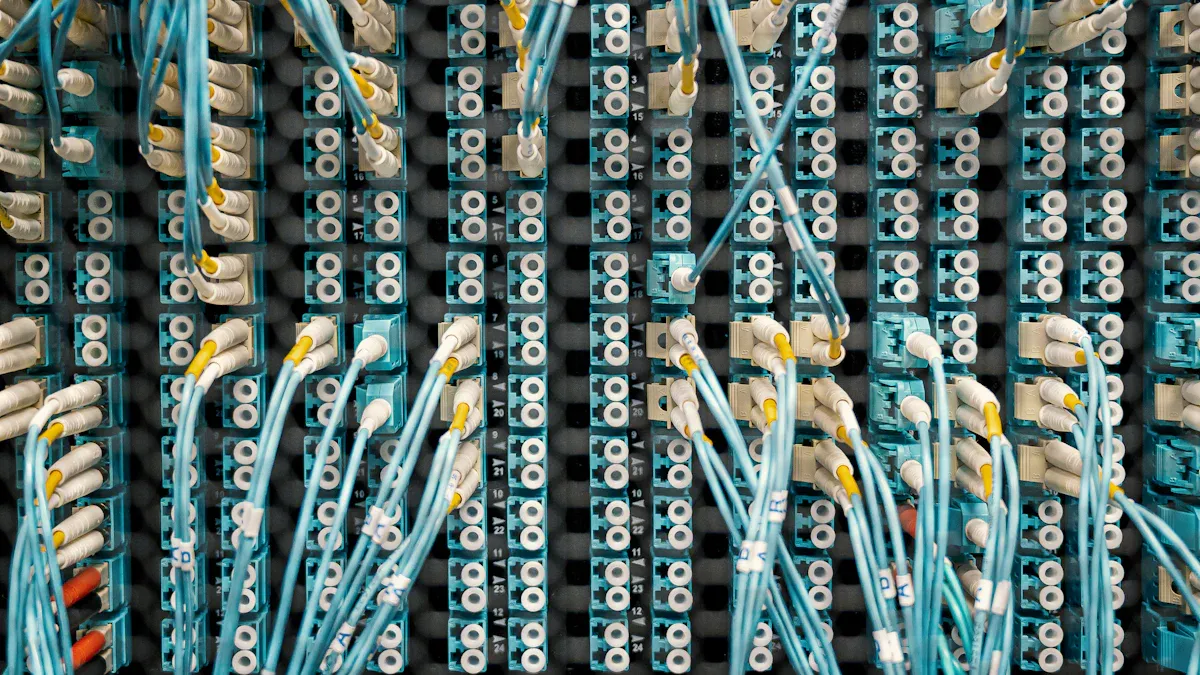
Data Centers
Data centers demand high-density, scalable solutions for rapid data transmission. MPO trunk cables meet these requirements by consolidating multiple fibers into a single, compact assembly. This design maximizes rack space and supports bandwidth-intensive applications. Pre-terminated cables reduce installation time and errors, enabling quick deployment and future upgrades.
Network engineers value the ability to scale capacity as bandwidth needs grow, without major rewiring.
MPO trunk cables also simplify cable management, which improves airflow and reduces congestion in crowded racks.
Telecommunications Networks
Telecommunications networks rely on robust, high-performance cabling for reliable service delivery.
- MPO trunk cables offer a high-density design that minimizes space requirements, ideal for telecom facilities.
- Modular construction allows quick connection and disconnection, reducing downtime during maintenance.
- These cables support both single-mode and multi-mode fibers, making them versatile for different network architectures.
- MPO trunk cables enable high-speed Ethernet and CWDM/DWDM systems, enhancing network performance.
- Pre-terminated assemblies reduce installation errors and time, facilitating efficient deployment.
Network operators benefit from low insertion loss and accurate fiber alignment, which support high data transfer rates and maintain signal quality.
Enterprise Infrastructure
Modern enterprises require flexible, scalable network infrastructure to support digital transformation. MPO trunk cables integrate multiple optical fibers into a single connector, supporting up to 144 fibers. This approach optimizes space and reduces signal loss in high-density environments. The push-pull coupling mechanism simplifies installation and expansion, allowing rapid deployment.
MPO trunk cables also use advanced fiber designs with low attenuation, ensuring high data transmission quality.
- Consolidate multiple fibers, reducing space consumption.
- Enable plug-and-play installation, minimizing errors.
- Simplify cable management and maintenance.
- Support high-bandwidth applications and future upgrades.
Although initial investment may be higher, enterprises realize long-term savings through reduced maintenance and efficient use of rack space.
Choosing the Right MPO Trunk Cable Supplier
Customization Options
Selecting the right supplier often depends on their ability to offer tailored solutions. Leading vendors provide a range of customization options to meet specific project needs.
- Custom cable lengths help avoid excess slack, reduce congestion, and improve cable management.
- Suppliers offer various cable jacket types, such as LSZH for indoor use, plenum for air-handling spaces, and ruggedized jackets for outdoor or industrial environments.
- Correct polarity configurations, like Polarity B, ensure proper signal alignment and network stability.
- Many suppliers support custom fiber counts and connector types, allowing seamless integration with existing infrastructure.
- Choosing a supplier who follows industry standards, such as TIA/EIA-568-B, ensures compatibility and supports future network growth.
Tip: Custom assemblies can reduce installation time and support scalability in data center environments.
Quality Assurance and Certifications
Quality assurance remains a top priority when evaluating MPO Trunk Cable suppliers. Reliable companies comply with international standards and hold widely recognized certifications. For example, certifications such as ROHS, CE, and OMC ISO indicate adherence to strict quality controls. Some manufacturers also meet AS9100D and ITAR requirements, and their products comply with NEC 770 for plenum-rated assemblies. Testing standards like EIA-455-171, NECA-FOA-301, and IEC 61280-4-5 further demonstrate a commitment to product reliability and performance. Suppliers should also verify that cables pass rigorous inspections, including IEC 61300-3-35 end-face and IEC 61755-3-31 geometry checks.
Technical Support and Service
Strong technical support and responsive service set top suppliers apart. Companies with dedicated support teams help customers select the right products, troubleshoot issues, and provide installation guidance. Many suppliers offer detailed documentation, training resources, and after-sales support. Fast response times and knowledgeable staff ensure smooth project execution and long-term satisfaction. Reliable service helps organizations maintain network uptime and adapt to evolving requirements.
Selecting a reputable MPO trunk cable supplier ensures network reliability and future scalability. Key factors include product quality, customization, certifications, and technical support.
Companies should evaluate project requirements and consult trusted suppliers for tailored solutions that meet performance and growth needs.
FAQ
What is the typical lead time for custom MPO trunk cable orders?
Most suppliers deliver custom MPO trunk cables within 5 to 10 business days. Lead times may vary based on order size and specific customization requirements.
How do you ensure correct polarity in MPO trunk cable installations?
Technicians use standardized polarity methods, such as Type A, B, or C. Clear labeling and proper documentation help maintain correct signal paths during installation.
Can MPO trunk cables support both single-mode and multi-mode fibers?
Yes. Manufacturers offer MPO trunk cables for both single-mode and multi-mode applications. Users should select the appropriate cable type for their network requirements.
